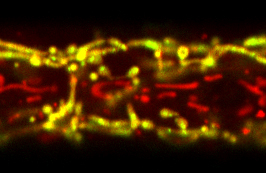

The glyoxylate shunt is localized to mitochondria in the worm. The C. elegans enzyme responsible for the glyoxylate shunt (ICL-1) is GFP tagged (green) and mitochondria are stained with a specific dye (red). In hypodermal cells (surrounding), ICL-1 is localized exclusively to mitochondria (yellow after merging) whereas in seam cells (center), it is not expressed.
A research team headed by Prof. Teymuras Kurzchalia at the MPI-CBG in Dresden found that nematodes and yeast can survive extreme desiccation by taking advantage of a metabolic shortcut, the glyoxylate shunt. This alternate metabolic route allows the production of sugars from fatty acids.
C. elegans dauer larvae and yeast can survive harsh conditions like extreme desiccation by bringing their metabolism down to an undetectable level. This ability depends on elevated amounts of a particular sugar, trehalose, which protects the cells from adverse effects of severe water loss. The Dresden research team showed that C. elegans dauer larvae can still produce sugars despite being in a non-feeding stage. The glyoxylate shunt, a metabolic shortcut, plays a central role in this process by allowing the production of sugars from fatty acids.
During a visit in Dresden of Dr. Sunil Laxman, a colleague from the Institute for Stem Cell Biology and Regenerative Medicine in Bangalore, an idea was born to also test the role of the glyoxylate shunt in yeast – the high desiccation tolerance of this organism has been exploited since centuries for producing bread and wine. Like in worms, the alternate metabolic route is crucial for survival in the absence of water or other water-related stresses, such as freezing, in yeast.
Thus far, no essential biological function has been assigned to the glyoxylate shunt. The study by Erkut et. al. challenges the textbook knowledge on the physiological importance of this pathway: “In fact, our paper should bring some corrections to the textbooks in biochemistry,“ says Kurzchalia.
Prof. Teymuras Kurzchalia
Max Planck Institute of
Molecular Cell Biology and Genetics
Pfotenhauerstr. 108
01307 Dresden
Germany
Tel. +49 (351) 210 2567
kurzchalia(at)mpi-cbg.de
Dr. Cihan Erkut
European Molecular Biology Laboratory
Meyerhofstr. 1
69117 Heidelberg
Germany
Tel. +49 (6221) 387 8313
cihan.erkut(at)embl.de
Cihan Erkut, Vamshidhar R Gade, Sunil Laxman, Teymuras V Kurzchalia:
The glyoxylate shunt is essential for desiccation tolerance in C. elegans and budding yeast
eLife, 19 April 2016